Devoted to Dairy
Vermont is renowned for dairy. Rich milk, both pasteurized and raw, forms the soul of myriad value-added products, including our world-class cheese, yogurt, and ice cream.
Our state is blessed with heroes who have embraced this vocation which some heed at a young age while others arrive by a more circuitous route. Despite fluctuating milk prices, slim margins, raising livestock for consumption while plant-based diets are on the rise the three farms featured here— The Corse Farm Dairy, Joneslan Farm, and Rebop Farm—are committed to land stewardship, soil conservation, sustainable practices, and peer education.
Fortunately for us, these farmers, and many peer farmers, are sticking with this vital calling. Let’s raise a glass of milk—or a bit of cheese—to that!
THE CORSE FARM DAIRY:
STEWARDING THE LAND FOR SIX GENERATIONS
 “We’ve had this land in our family since 1868, but we don’t ‘own’ it; we’re just one family in a long line of caregivers.” –Leon Corse
“We’ve had this land in our family since 1868, but we don’t ‘own’ it; we’re just one family in a long line of caregivers.” –Leon Corse

Pancake, a Jersey-Holstein cross, happily forages a salad bowl of red clover, broadleaf plantain, reed canary, and timothy grasses.. PHOTOGRAPHS COURTESY THE CORSE FARM DAIRY
Abbie Corse enters the airy barn and calls out cows by name, gently rubbing their soft, wet noses as they amble over to greet her. “These are my goddesses, literally! This one is Hera, that’s Calliope, and Ceres is over there.” The Corse family tends 100 cows, a mixed herd of Holsteins and Jerseys. “That’s a manageable size for us and for our pastures,” Abbie explains. “Jerseys are efficient grass-conversion machines and worth their weight in gold, or butterfat. They’re smart and curious troublemakers, which I find endearing, but Dad thinks it’s annoying.”
Abbie grew up on the family farm along with her two brothers, Caleb and Henry. But she harbored no interest in being a farmer. That changed in 2007, after the barn burned and her parents had to decide whether to continue or not. Abbie surprised everyone, herself most of all, when she quit her office job and came home to farm. “I realized this is where I feel most alive,” she explains. Abbie is now the sixth generation to steward these 300 acres high above Whitingham in far southern Vermont.
Farming at a 2,000-feet elevation comes with some benefits and some challenges. Abbie’s dad, Leon, recalls only two or three summers of extreme drought in his lifetime, and he says the grass grows really well here. But the soil is wet and rocky, and the wind can be tough on a farm with a broad western exposure. “The wind starts in the Rockies and doesn’t stop till it hits Whitingham,” he says, only half in jest, then adds, “On paper, our farm isn’t viable.” But printed words on paper belie the majesty of doe-eyed cows grazing lush hilltop pastures. As they have for the last 154 years.
“I learned to farm by listening to what the soil and the land tell me,” Leon explains in his gentle voice. “Forcing Mother Nature doesn’t work here. We have an extreme terrain, excessive winters, and a growing season too short for corn or alfalfa. So we just let the grasses grow naturally, and that’s clearly sustaining our cows.”
“We’ve had this land in our family since 1868,” Leon continues, “but we don’t ‘own’ it; we’re just one family in a long line of caregivers. Every generation has moved the farm forward with some significant change. My father financed the barn and other buildings; I transformed the farm to organic. And Abbie? In addition to coming back and infusing the farm—and family—with new energy, she may leave her mark through agroforestry, adding trees back to the landscape to enhance the ecosystems for generations to come. Stewardship of the land is our guiding principle, and resilience is embedded in this rocky soil. I wanted my kids, and grandkids, to be raised having that sense of place.” Linda, Leon’s wife of 42 years, adds, “A farm is like a boat: It can hold you steady as an anchor or drag you and keep you from moving.”
The Corse Farm Dairy earned its organic certification in May 2008, and their milk has been on the Organic Valley truck for almost 14 years now. “Organic Valley is focused on keeping their milk regional; Northeast milk stays in the Northeast,” Leon says.
The Corse Farm will ultimately transition to Abbie, who lives in another family farmhouse just down the road with her husband, Dave, a carpenter, and their two young sons, Eli and Niko. “Working together as a family is the heart of the farm and keeps us going,” says Linda, proud mom and grandmother. “This is a true partnership, and everyone has a voice. A strong voice.”
- thecorsefarmdairy.com
- @thecorsefarm
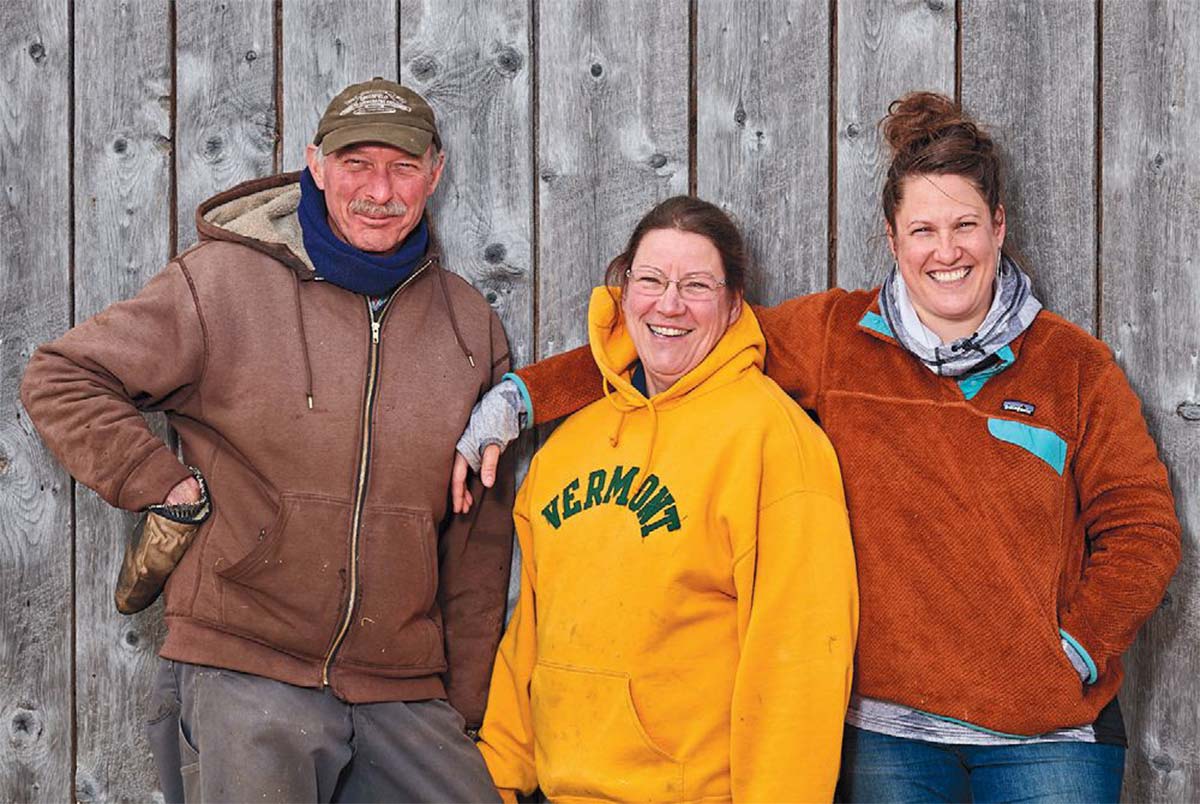
Fifth and sixth generations working together: Leon, Linda, and Abbie Corse.
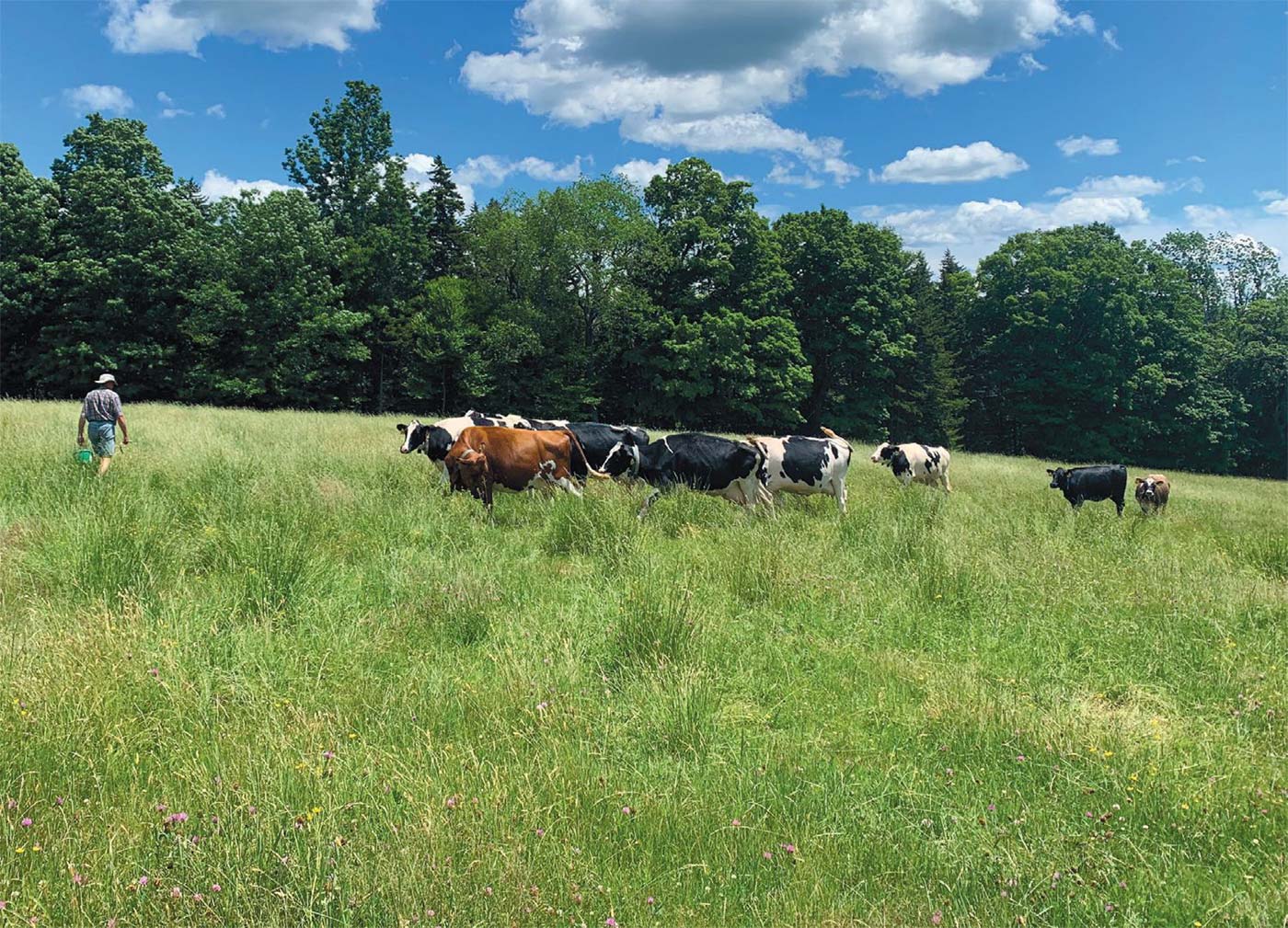
Rotational Grazing
Dairy farms in Vermont manage 80 percent of the open land in the state. On farms that practice rotational grazing, you’ll see lush pastures and healthy soil, not muddy, trampled, eroded terrain. The Corse family has always raised their dairy cows on pasture. “My father, Lewis, started to graze his cows rotationally back in the 1960s, way ahead of his peers,” Leon says. “We had wooden fence posts and steel wire. He would carry an iron bar out to the pasture to move and reset those posts and wires to get the cows on new grass.” When fiberglass posts and single-strand polywire became the norm in the 1980s, that daily chore became significantly less labor intensive.
Rotational grazing helps to improve long-term pasture quality and increases fertility as the cows distribute their manure more evenly rather than in one consolidated area of a permanent pasture. Moving cows regularly to new pasture prevents overgrazing and allows grasses to regrow more quickly. It’s a win-win-win: cows, grass, and soil. And all that impacts the quality and quantity of milk produced.
JONESLAN FARM:
TRANSITIONING FROM COWS TO GOATS
Brian was scrolling through the internet in 2018, found some goat videos, and started to wonder how many goats they could fit in their barn.

Curious, lovable goats at Joneslan Farm in North Hyde Park. PHOTOGRAPHS BY MARIA BUTEUX READE
If the pandemic has taught us anything, it’s to embrace change, to transform loss into opportunity.
Brian and Steve Jones, who grew up on their family’s 150-year-old dairy farm in Hyde Park, were doing everything they could to keep Joneslan Farm in the black. The brothers had been running the farm since they were in their 20s and experienced the constant pressure to expand the herd to produce more milk to pay more bills. “Our parents were milking around 70 cows when we were kids in the 1970s, and by 2013, we were up to 300 cows,” Steve says. “And still struggling to make ends meet,” Brian adds.
Brian was scrolling through the internet in 2018, found some goat videos, and started to wonder how many goats they could fit in their barn. “I did some research about the square footage per goat and realized we could milk about 1,200 and make it work. Then we got a little more serious about the possibility.”
The brothers went down to Randolph and met Miles Hooper at his farm, Ayers Brook Goat Dairy. Miles introduced the Joneses to Adeline Druart, president of Vermont Creamery, who was eager to source more goat milk directly from Vermont for their rapidly expanding cheese market. Land O’Lakes had bought Vermont Creamery in 2017 and was scaling up the company. About the same time, Dairy Farmers of America (DFA) had taken over St. Albans Co-op, where Joneslan Farm milk had been shipped for decades. “With all those forces happening at once, we took that as a sign to make a change,” Brian explains.
“Goats are the next chapter in Vermont’s long and rich agricultural history,” says Adeline.
“As demand for goats’ milk cheeses continues to grow across the country, Vermont Creamery is working closely with partners to help goat farms be part of a stronger, more diverse agricultural system in Vermont. We are not only enthusiastic about the promising future for Vermont farmers who consider transitioning to goats, but also for the reduced environmental impact of goat farms.”
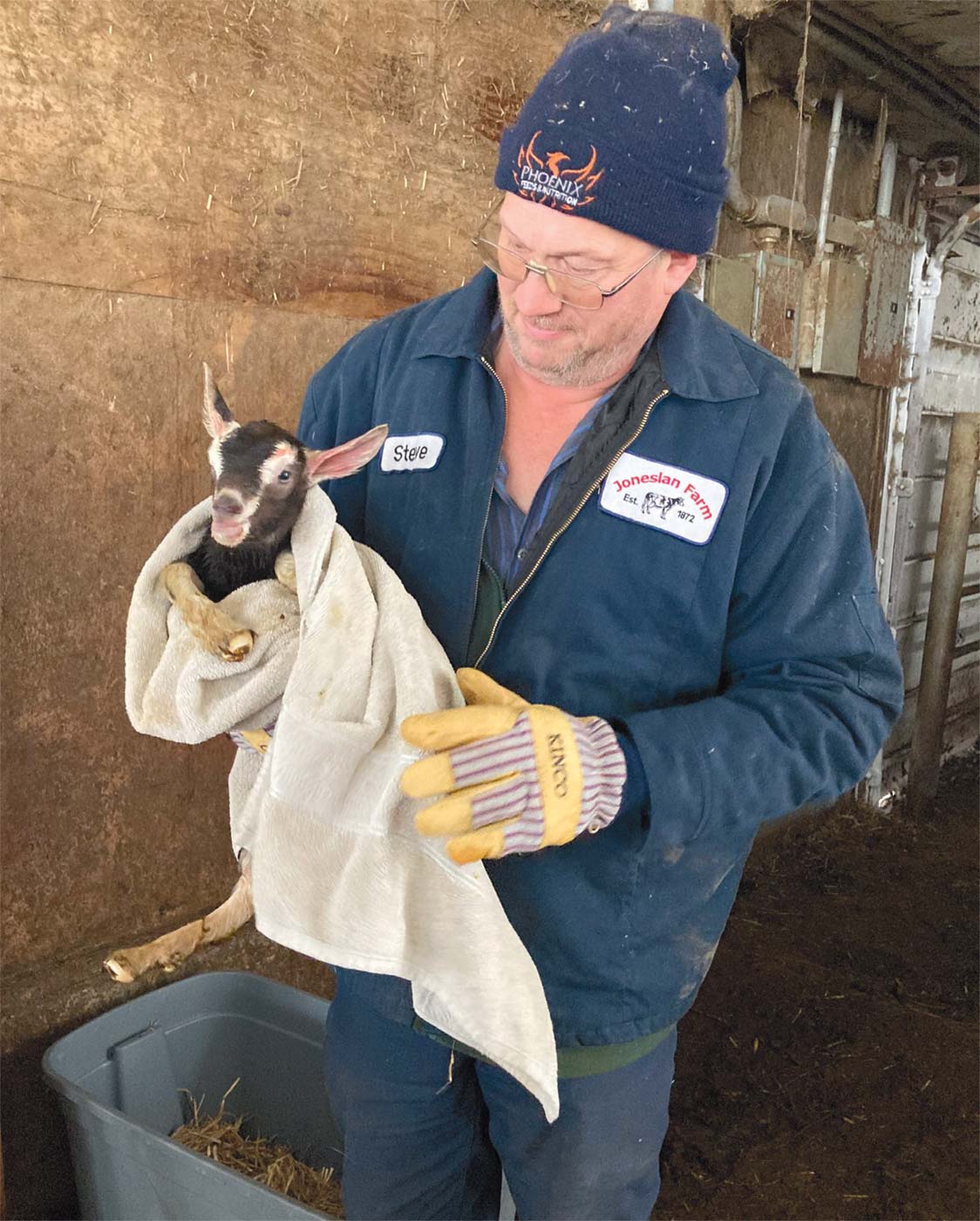
Steve Jones gently swaddles a goat kid born just moments before.
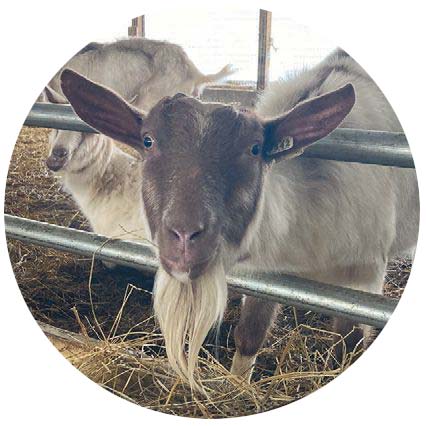 “Goats are pretty curious and friendly and won’t leave you alone. Near impossible to fix anything in the pens though; they’ll come up and try to climb all over you.” –Steve Jones Joneslan Farm
“Goats are pretty curious and friendly and won’t leave you alone. Near impossible to fix anything in the pens though; they’ll come up and try to climb all over you.” –Steve Jones Joneslan Farm
Anson Tebbetts (Vermont’s Secretary of Agriculture, Food, and Markets) met with Brian and Steve in 2019, and that led to the Working Lands grant that Joneslan Farm received in January 2020. That grant, along with financing from the Castanea Group and the Vermont Community Loan Foundation, allowed the brothers to retrofit their barn and to set up infrastructure to shift from 300 cows to 1,500 goats. “Miles Hooper helped us source our goats, and I went out to Wisconsin to visit several large-scale goat dairy operations,” Brian says.
And then, the pandemic struck, just as Brian and Steve were getting ready to auction their herd and equipment.
“Up until that moment, cow prices had been real good,” Brian recalls. “Our auction was scheduled for March 2020. Of course, that got cancelled. We were scrambling, pretty scared, and didn’t know what to do. The price of milk was plummeting, and the price of cows followed. But we got connected with a large dairy in New York State who eventually bought the herd later that spring. We lost a lot of money, but at least we stayed afloat.”
Brian pauses. “It was pretty rough to sell the herd. We had some deep bloodlines here started by our grandfather in the 1940s. The day the cows left, that was tough. Reality hit, like, oh crap, this is really happening. For the first time ever, the barn was empty and the farm was quiet. But we had plenty to do to get ready for the goats.”
Steve adds, “We had originally planned to bring in the goats and start milking in July 2020, then everything snowballed and got delayed. But that actually gave us more time to get our infrastructure up.”
Brian found a used rotary milking parlor with slots to milk 60 goats at a time (imagine a giant, slow-moving merry-go-round) up in Ontario, 10 hours north of Hyde Park. But the goats arrived before the brothers could get the complicated, massive rig down from Canada and reassembled.
The first trailer load of 280 goats came from Wisconsin in the first week of December 2020, and the second trailer of 330 arrived a week later. The does weren’t supposed to have their kids until late January, but kidding started the week before Christmas. “We had 80 kids born in three days, and then it was all-hands-on-deck,” Steve recalls. “And since the parlor wasn’t ready yet, we had to do all the milking with a portable milker that could only handle two goats at a time. Even with a lot of family help, it still took us 5½ hours each end of the day to milk all 240 goats. And we did that for six weeks until we completed the parlor the first week of February 2021.”
The Joneslan goats—Saanen, Alpine, and LaMancha breeds— live inside the spacious barn on a deep-bedded pack of straw. “It’s simpler and less expensive to feed goats than cows,” Brian says. “They just eat dry hay and a little bit of grain. When we’re at full capacity, milking 1,200 or 1,500 goats, we’ll make the same gross income that we did with 300 cows and have fewer expenses, with the milk going directly to Vermont Creamery. And it’s easier to work with 150-pound goats than 1,200-pound cows. Housing them inside keeps them healthier because they don’t pick up parasites from grazing the pastures. They have a pretty good life in the barn, with natural light and ventilation. The sides lift up when it gets above 30 or 40 degrees and let in fresh air.”
And their personality?
“Goats are pretty curious and friendly and won’t leave you alone,” Steve says with a grin. “Near impossible to fix anything in the pens though; they’ll come up and try to climb all over you.”
“A lot of people are interested and watching us to see how things go,” Brian concludes. “Assuming all things go right, we’ll be Vermont’s largest goat dairy. The state is happy we’re doing this because they know this could be a possible option for some other dairy farms. Ten years ago, if you’d said we’d be goat farmers, we’d have said no way. But here we are. No regrets.”
And for the record, Brian likes Vermont Creamery cranberry goat cheese crumbles on a salad while Steve prefers the honey goat cheese spread on crackers. And they both love the salted butter, even though it’s not made with goat milk.
REBOP FARM:
RESTORING LAND THROUGH DIVERSIFICATION
“Having animals on those hillsides and pastures has improved the land by keeping invasives at bay and adding fertility and organic matter to the soil.” –Ashlyn Bristle

Ashlyn Bristle loving up one of her nine Jersey dairy cows. PHOTOGRAPHS COURTESY REBOP FARM
Some people are born into farming, others come to the land by a more circuitous path. Ashlyn Bristle and Abraham McClurg, stewards of Rebop Farm in Brattleboro, belong to the latter group of mere mortals. Ashlyn started milking cows as a side gig during art school in North Carolina; Abraham raised bees while living in Chicago.
Milking cows, keeping bees, and grazing livestock remain the heart of Rebop Farm, located up a two-and-a-half-mile dirt road in the hills above Brattleboro. Steep barely describes the farm’s 17-percent-grade terrain, an unlikely place to raise pastured animals, but it’s what the couple could afford at the time. “We find ways to make it work,” Ashlyn says matter-of-factly.
Rebop Farm was established in 2016. “This land had last been farmed in the 1940s,” Ashlyn explains. “When we moved here, brushy invasives had taken over. We spent that first summer clearing and bringing back the land so our livestock could start rotational grazing. Having animals on those hillsides and pastures has improved the land by keeping invasives at bay and adding fertility and organic matter to the soil.”
“Being an animal farm in this world of climate change may cause some to raise an eyebrow,” Ashlyn acknowledges, “but we’re adhering to environmentally sustainable practices and improving the land. We’re livestock producers and environmentalists. We’re transparent with how and why we grow things. If you’re going to eat meat and drink milk, we have some really healthy options.”
A flock of 65 Katahdin sheep now graze the swath under a power line that stretches up the hillside; a herd of nine Jersey cows enjoys the pastures adjacent to the couple’s home; 1,600 meat birds move about the lower fields accompanied by their portable chicken tractors; and 80 heritage breed hogs reside in a large hoop barn, contentedly rooting about and turning the deep woodchip bed into compost that enriches the gardens.
At the base of the farm sits a beautiful and well-stocked store built in 2019 where customers and shareholders can purchase items from more than 90 purveyors. Rebop Farm offers both a raw milk CSA membership—glass jars of fresh, creamy raw milk from the farm’s Jersey cows—and a pastured frozen meat CSA that includes chicken, beef, lamb, turkey, rose veal, pork, bones, and offal. “We offer a winter share and a summer share, and shareholders can choose from three levels: small, medium, or large,” Abraham says. How does the couple divide and conquer? Ashlyn oversees living things: anything that needs to be managed, bred, or processed, from the animals to the grazing systems. Abraham handles facilities, equipment, bookkeeping, inventory, and the retail store. “I’m the planner and he's the master of customer service,” Ashlyn says. Then she laughs. “The cool and challenging thing about animals is that they are chaos machines. I will have our workday beautifully planned, but that can all go out the window if an animal is not doing well.”
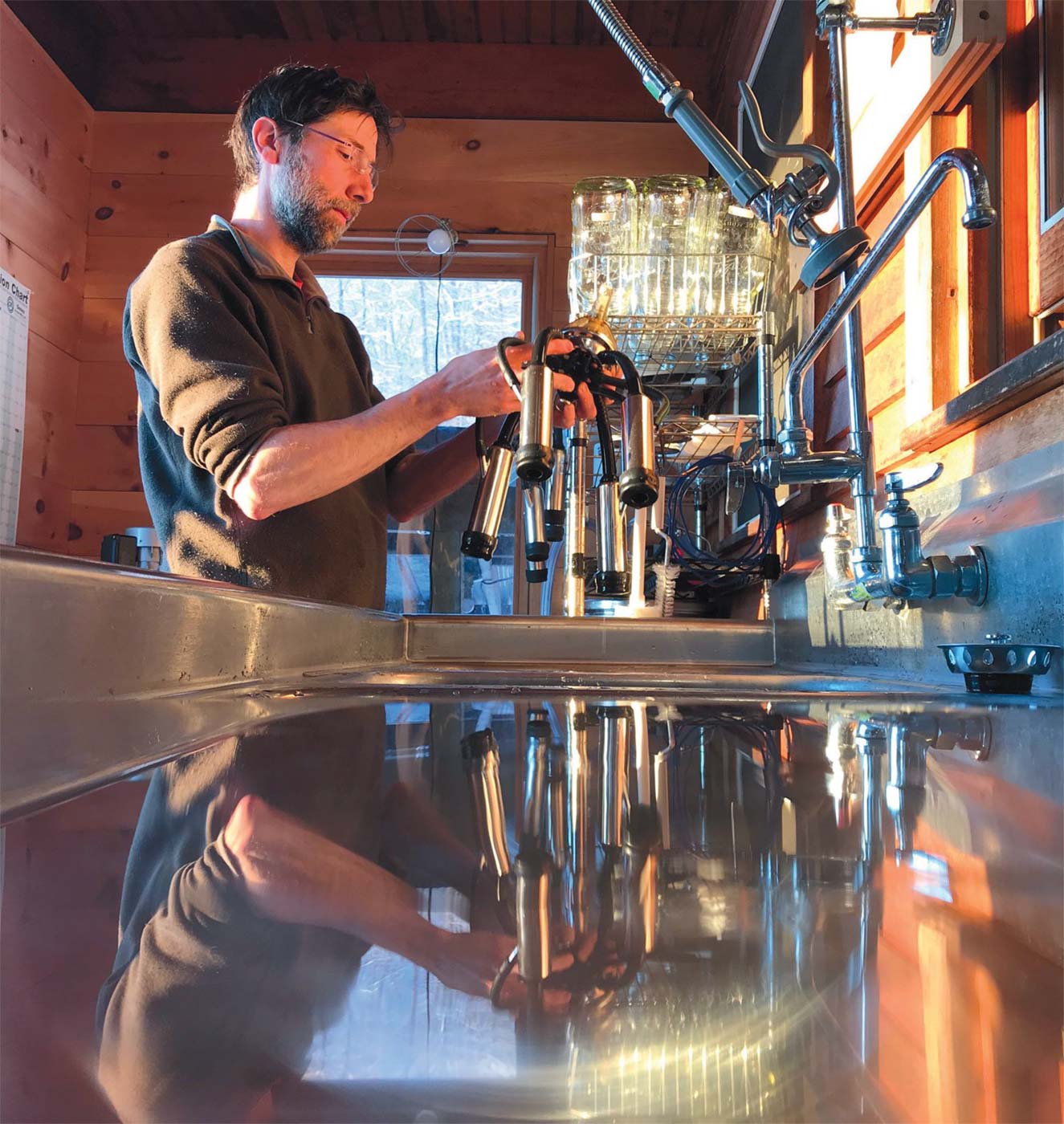
Abraham McClurg in the sparkling clean milk room at Rebop Farm.
If animals are chaos machines, farmers are learning machines. In the midst of managing the farm, Ashlyn went back to school online and studied sustainable food and farming through the University of Massachusetts, Amherst. She earned her degree in January 2021. “I had been an art major, so I took as many soil science classes as I could. I dug deep into how grazing improves the soil and significantly increases the level of organic matter. We can now carry more animals because of dense pasture growth and high fertility and not lose soil to erosion, which is essential on an extreme hill farm like ours. We are land managers first, then food producers, then a place to support community. Those are the three tenets to our mission.”
Rebop Farm is also part of the Jack Lazor Memorial Soil Health Cohort, created by NOFA-VT and funded by Stonyfield Organic. “Jack’s passion was soil health. Animals need to stay healthy, and the land has to be well managed to produce enough food for the livestock. Our peer-to-peer learning group of livestock grazers and soil health consultants visited farms to discuss what worked and to problem-solve together. It was interesting to step out of our ecological bubble and see what other farms are experiencing around the state. Farmers know so much and bring such depth of experience, so it’s invaluable to gather and learn from one another.”
While Ashlyn has taught Abraham a great deal about farming, he’s the expert in beekeeping and found an eager student in Ashlyn. “It can be scary the first time you open a hive if you don’t have any experience,” Ashlyn admits. “We’re conditioned to be afraid of stinging insects, for good reason. You learn to read the bees. Listen as you approach them and figure out what’s their mood today. Bees react to your mood and your smell as well, so it’s crucial to remain calm and move slowly and gently. You need to act like the bees are your friends. It was so wonderful for me to be able to learn from Abraham how to work with the bees. It’s similar to learning to work with the cows. There’s no reason a 1,500-pound cow should listen to or respect what I, as a small human, ask it to do. But you develop a relationship and patterns and learn to communicate respectfully with one another.”
Why are bees important? “Not only are they reliable pollinators that I can count on,” Ashlyn observes, “it’s just so beautiful to see them working across the farm, doing their job. It’s like we’re coworkers, all committed to one goal: creating a healthy ecosystem.




